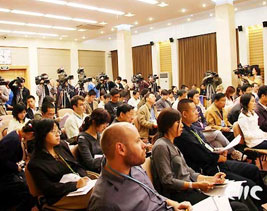Source: Xinhuanet
10-12-2006 10:08
Related : Full text: China's Space Activities in 2006
 |
BEIJING, Oct. 12 (Xinhua) -- China on Thursday published a white paper on space activities, illustrating the development of China's space industry over the past five years and its plans for the near future.
 |
The 8,500-character white paper, the second of its kind since 2000, is titled "China's Space Activities in 2006" and released by the Information Office of the State Council, China's cabinet.
The white paper introduces the aims and principles of China's space development, progress made in the past five years, development targets and major tasks for the next five years, development policies and measures and international exchanges and cooperation.
The white paper says it has been 50 "splendid" years since China embarked on the road to develop its space industry, startingin 1956. For half a century, China has made eye-catching achievements, and ranks among the world's most advanced countries in some important fields of space technology.
In the new stage of development, China will "center its work onthe national strategic goals, strengthen its innovative capabilities and do its best to make the country's space industry develop faster and better," the white paper says.
Introducing the major tasks of China's space industry in the coming five years, the white paper says China will give priority to the development of applied satellites and construct a comprehensive chain of space industry covering satellite manufacturing, launching services, ground equipment production and operational services.
China will start and implement a high-resolution Earth observation system; develop and launch new-type sun synchronous orbit and geostationary-orbit meteorological satellites, oceanic satellites, Earth resources satellites, small satellites for environmental protection and disaster mitigation monitoring and forecasting.
Over the past five years, China has independently developed and launched 22 different types of man-made satellites, upgrading its overall level in this field markedly.
China plans to develop nontoxic, pollution-free, high-performance, low-cost and powerful thrust carrier rockets of the new generation in the coming five years, according to the white paper.
China aims to increase the carrying capacity of near-Earth orbiters to 25 tons, and that of geostationary orbiters to 14 tons.
China will also develop in an overall way the 120-ton thrust liquid-oxygen/kerosene engine and the 50-ton thrust hydrogen-oxygen engine, and increase the reliability and adaptability of the present "Long March" carrier rockets.
"Long March" rockets independently developed by China have made24 consecutive successful flights over the past five years, and their major technological functions and reliability have been notably upgraded, says the white paper.
China aims to enable astronauts to engage in extravehicular operations and conduct experiments on spacecraft rendezvous and docking, according to the white paper.
China will carry out research on short-term manned and long-term autonomously orbiting space laboratories, which is of certain application scale, and carry out follow-up work of manned spaceflight, it says.
On October 15 and 16, 2003, China launched and retrieved the "Shenzhou V" manned spacecraft, China's first of its kind. Having mastered the basic technologies for manned spacecraft, China became the third country in the world to develop manned spaceflight independently.
From October 12 to 17, 2005, the "Shenzhou VI" manned spacecraft completed a five-day flight with two astronauts on board. This was the first time for China to have men engage in experiments in space.
In its space plan, China will realize lunar-orbiting probe in the coming five years, making breakthroughs in developing basic technologies for lunar exploration.
China will develop and launch its first lunar probe satellite "Chang'e I" for lunar science and lunar resources exploration, andcarry out final-period work for the lunar exploration project.
To further consolidate the nation's position in the world spaceindustry and boost its space programs, China is aiming to building" world-class large space corporations" to provide a market-based mechanism of development.
The Chinese government will increase input to the space industry, and at the same time encourage the establishment of a diverse, multi-channel space funding system, so as to guarantee the sustainable and stable development of the space industry, the white paper says.
China's space programs today is now solely funded by the government.
Editor:Sun Luying
